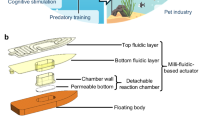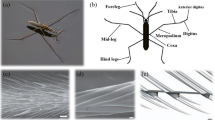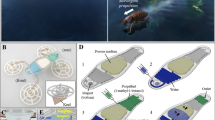Abstract
This paper reviews and discusses the propulsion of water-floating natural creatures and man-made devices at the air-water interface. Natural creatures with a large ratio of body weight to surface tension force normally propel themselves by repeatedly slapping and stroking their feet while natural creatures with a small ratio of body weight to surface tension force are floated dominantly by surface tension and are propelled by various propulsion mechanisms. Some animals developed unique walking and propelling methods such as leaping, sailing, meniscus climbing, and utilizing of Marangoni effect. Inspired by the natural creatures, a large number of water walking robots and propulsion methods have been developed. Many of them are based on the walking and propelling of water striders, although they require complicated fabrication and structures. Some of the recently developed devices are propelled by the gradient of surface tension (via addition of heat or surfactant) or by streaming flows (induced from oscillations of bubbles or interfaces). These methods need relatively simple mechanical structures and fabrication but are effective only in limited conditions. The bio-inspired water floating and propelling systems can be applied to environment monitoring systems, surveillance security systems, educational robots, and toys. In particular, this paper suggests applying those systems to “smart dust” sensory robots and pollutant collecting devices.
Similar content being viewed by others
References
Y. S. Song and M. Sitti, Surface-tension-driven biologically inspired water strider robots: theory and experiments, IEEE Transactions on Robotics, 23 (2007) 578–589.
S. K. Chung, K. Ryu and S. K. Cho, Electrowetting propulsion of water-floating objects, Applied Physics Letters, 95 (2009) 014107.
O. Ozcan, H. Wang, J. D. Taylor and Metin Sitti, Surface tension driven water strider robot using circular footpads, IEEE International Conference on Robotics and Automation, (2010) 3799–3804.
D. L. Hu, B. Chan and J. W. Bush, The hydrodynamics of water strider locomotion, Nature, 424 (2003) 663–666.
J. W. Glasheen and T. A. McMahon, A hydrodynamic model of locomotion in the basilisk lizard, Nature, 380 (1996) 340–342.
R. Baudoin, La physico-chimie des surfaces dans la vie des Arthropodes aeriens des miroirs d’eau, des rivages marins et lacustres et de la zone intercotidale, Bull. Biol. France Belg., 89 (1955) 16–164.
S. T. Hsieh, Three-dimensional hindlimb kinematics of water running in the plumed basilisk lizard (Basiliscus plumifrons), J Exp Biol, 206 (2003) 4363–4377.
S. T. Hsieh and G. V. Lauder, Running on water: Three-dimensional force generation by basilisk lizards, Proc Natl Acad Sci U S A, 101 (2004) 16784–16788.
J. W. Glasheen and T. A. McMahon, Size-dependence of water-running ability in basilisk lizards (Basiliscus basiliscus), J Exp Biol, 199 (1996) 2611–2618.
X. Gao and L. Jiang, Biophysics: water-repellent legs of water striders, Nature, 432 (2004) 36.
M. Dickinson, Animal locomotion: how to walk on water, Nature, 424 (2003) 621–622.
X. Q. Feng, X. Gao, Z. Wu, L. Jiang and Q. S. Zheng, Superior water repellency of water strider legs with hierarchical structures: experiments and analysis, Langmuir, 23(9) (2007) 4892–4896.
Y. Su, B. Ji, Y. Huang and K. C. Hwang, Nature’s design of hierarchical superhydrophobic surfaces of a water strider for low adhesion and low-energy dissipation, Langmuir, 26(24) (2010) 18926–18937.
D. Vella, Floating objects with finite resistance to bending, Langmuir, 24(16) (2008) 8701–8706.
K. J. Park and H.-Y. Kim, Bending of floating flexible legs, Journal of Fluid Mechanics, 610 (2008) 381–390.
X. Y. Ji, J. W. Wang and X. Q. Feng, Role of flexibility in the water repellency of water strider legs: Theory and experiment, Phys Rev E Stat Nonlin Soft Matter Phys, 85(2-1) (2012) 021607.
R. B. Suter, G. E. Stratton and P. R. Miller, Taxonomic variation among spiders in the ability to repel water: surface adhesion and hair density, The Journal of Arachnology, 32 (2004) 11–21.
M. Prakash and J. W. M. Bush, Interfacial propulsion by directional adhesion, International Journal of Non-Linear Mechanics, 46 (2011) 607–615.
M. A. Caponigro and C. H. Eriksen, Surface film locomotion by the water strider, Gerris remigis Say, American Midland Naturalist, 95 (1976) 268–278.
M. W. Denny, Air and water: The biology and physics of life’s media. Princeton University Press, Princeton, NJ, (1993).
R. Suter, O. Rosenberg, S. Loeb and H. Long, Locomotion on the water surface: propulsive mechanisms of the fisher spider DOLOMEDES TRITON, J Exp Biol, 200 (1997) 2523–2538.
M. W. Denny, Paradox lost: answers and questions about walking on water, The Journal of Experimental Biology, 207 (2004) 1601–1606.
O. Bühler, Impulsive fluid forcing and water strider locomotion, J. Fluid Mechanics, 573 (2007) 211–236.
P. Gao and J. J. Feng, A numerical investigation of the propulsion of water walkers, J. Fluid Mechanics, 668 (2011) 363–383.
D. L. HU and J. W. M. BUSH, The hydrodynamics of waterwalking arthropods, J. Fluid Mechanics, 644 (2010) 5–33.
R. B. Suter and H. Wildman, Locomotion on the water surface: hydrodynamic constraints on rowing velocity require a gait change, J Exp Biol, 202 (Pt 20) (1999) 2771–2785.
R. B. Suter and J. Gruenwald, Predator avoidance on the water surface? Kinematics and efficacy of vertical jumping by Dolomedes (ARANEAE, PISAURIDAE), The Journal of Arachnology, 28 (2000) 201–210.
R. B. Suter, Trichobothrial mediation of an aquatic escape response: directional jumps by the fishing spider, Dolomedes triton, foil frog attacks, J Insect Sci, 3 (2003) 19.
G. S. Deshefy, ’sailing’ behaviour in the fishing spider, Dolomedes triton (Walckenaer), Anim. Behav., 29 (1981) 965–966.
R. B. Suter, Cheap transport for fishing spiders (Araneae, Pisauridae): The physics of sailing on the water surface, Journal of Arachnology, 27 (1999) 489–496.
M. Denny, The role of gastropod pedal mucus in locomotion, Nature, 285 (1980) 160–161.
S. Lee, J. W. Bush, A. E. Hosoi and E. Lauga, Crawling beneath the free surface: Water snail locomotion, Phys. Fluids, 20 (2008) 082106.
D. L. Hu and J. W. Bush, Meniscus-climbing insects, Nature, 437 (2005) 733–736.
J. W. Bush and D. L. Hu, Walking on water: Biolocomotion at the interface, Annu. Rev. Fluid Mech., 38 (2006) 339–369.
S. Floyd, T. Keegan, J. Palmisano and M. Sitti, A novel water running robot inspired by basilisk lizards, Proceedings of the 2006 IEEE/RSJ, International Conference on Intelligent Robots and Systems, (2006) 5430–5436.
S. Floyd, S. Adilak, S. Ramirez, R. Rogman and M. Sitti, Performance of different doot designs for a water running robot, IEEE International Conference on Robotics and Automation, (2008) 244–250.
S. Floyd and M. Sitti, Design and development of the lifting and propulsion mechanism for a biologically inspired water runner robot, IEEE Transactions on Robotics, 24 (2008) 698–709.
H. S. Park, S. Floyd and M. Sitti, Dynamic modeling and analysis of pitch motion of a basilisk lizard inspired quadruped robot running on water, IEEE International Conference on Robotics and Automation, (2009) 2655–2660.
H. S. Park, S. Floyd and M. Sitti, Dynamic modeling of a basilisk lizard inspired quadruped robot running on water, IEEE/RSJ International Conference on Intelligent Robots and Systems, (2008) 3101–3107.
H. S. Park, S. Floyd and M. Sitti, Roll and pitch motion analysis of a biologically inspired quadruped water runner robot, The International Journal of Robotics Research, 29 (2010) 1281–1297.
H. Takonobu, K. Kodaira and H. Takeda, Water strider’s muscle arrangement-based robot, IEEE/RSJ International Conference on Intelligent Robots and Systems, (2005) 1754–1759.
D. L. Hu, M. Prakash, B. Chan and J. W. M. Bush, Waterwalking devices, Exp Fluids, 43 (2007) 769–778.
S. H. Suhr, Y. S. Song, S. J. Lee and M. Sitti, Biologically inspired miniature water strider robot, Proc. Robot.: Sci. Syst. I,, (2005) 319–325.
X. Zhang, J. Zhao, Q. Zhu, N. Chen, M. Zhang and Q. Pan, Bioinspired aquatic microrobot capable of walking on water surface like a water strider, ACS Appl Mater Interfaces, 3(7) (2011) 2630–2636.
Y. S. Song and M. Sitti, STRIDE: A highly maneuverable and non-tethered water strider robot, IEEE International Conference on Robotics and Automation, (2007) 980–984.
K. Suzuki, H. Takanobu, K. Noya, H. Koike and H. Miura, Water strider robots with microfabricated hydrophobic legs, Proceedings of the 2007 IEEE/RSJ, International Conference on Intelligent Robots and Systems, (2007) 590–595.
L. Wu, Z. Lian, H. Yuan, S. Wang and G. Yang, A nontethered telecontrollable water strider robot prototype, International Conference on Intelligent Control and Information Processing, (2010) 792–797.
L. Wu, Z. Lian, G. Yang and M. Ceccarelli, Water dancer II-a: a non-tethered telecontrollable water strider robot, Int J Adv Robotic Sy, 8 (2011) 10–17.
F. Shi, Z. Wang and X. Zhang, Combining a layer-by-layer assembling technique with electrochemical deposition of gold aggregates to mimic the legs of water striders, Advanced Matterials, 17 (2005) 1005–1009.
X. Wu and G. Shi, Production and characterization of stable superhydrophobic surfaces sased on copper hydroxide nanoneedles mimicking the legs of water striders, J. Phys. Chem. B, 110 (2006) 11247–11252.
Y. Ding, S. Xu, Y. Zhang, A. C. Wang, M. H. Wang, Y. Xiu, C. P. Wong and Z. L. Wang, Modifying the antiwetting property of butterfly wings and water strider legs by atomic layer deposition coating: surface materials versus geometry, Nanotechnology, 19(35) (2008) 355708.
H. Wu, R. Zhang, Y. Sun, D. Lin and Z. Sun, Biomimetic nanofiber patterns with controlled wettability, Soft Matter, 4 (2008) 2429–2433.
L. Jiang, X. Yao, H. Li, Y. Fu, L. Chen, Q. Meng, W. Hu and L. Jiang, “Water strider” legs with a self-assembled coating of single-crystalline nanowires of an organic semiconductor, Adv Mater, 22(3) (2010) 376–379.
Q. Pan, J. Liu and Q. Zhu, A water strider-like model with large and stable loading capacity fabricated from superhydrophobic copper foils, Applied Materials and Interfaces, 2 (2010) 2026–2030.
Y. S. Song, S. H. Suhr and M. Sitti, Modeling of the supporting legs for designing biomimetic water strider robots, Proceedings of the 2006 IEEE International Conference on Robotics and Automation, (2006) 2303–2310.
D. Vella, D. G. Lee and H. Y. Kim, The load supported by small floating objects, Langmuir, 22(14) (2006) 5979–5981.
L. Wu, S. Wang, C. Marco, H. Yuan and G. Yang, Shape and location design of supporting legs for a new water strider robot, IEEE/RSJ International Conference on Intelligent Robots and Systems, (2011) 5061–5066.
B. Shin, H.-Y. Kim and K.-J. Cho, Towards a biologically inspired small-scale water jumping robot, Proceedings of the 2nd Biennial IEEE/RAS-EMBS International Conference on Biomedical Robotics and Biomechatronics, (2008) 127–131.
C. Luo, H. Li and X. Liu, Propulsion of microboats using isopropyl alcohol as a propellant, J. Micromech. Microeng., 18 (2008) 067002.
N. J. Suematsu, Y. Miyahara, Y. Matsuda and S. Nakata, Self-motion of a benzoquinone disk coupled with a redox reaction, J. Phys. Chem. C, 114 (2010) 13340–13343.
E. Hendarto and Y. B. Gianchandani, Marangoni-driven micromotor in liquid medium, Solid-State Sensors, Actuators and Microsystems Conference (TRANSDUCERS), 2011 16th International, (2011) 246–249.
J. M. Won, J. H. Lee, K. H. Lee, K. Rhee and S. K. Chung, Propulsion of water-floating objects by acoustically oscillating microbubbles, International Journal of Precision Enginnering and Manufacturing, 12 (2011) 577–580.
Y. Mita, Y. Li, M. Kubota, S. Morishita, W. Parkes, L. I. Haworth, B. W. Flynn, J. G. Terry, T.-B. Tang, A. D. Ruthven, S. Smith and A. J. Walton, Demonstration of a wireless driven MEMS pond skater that uses EWOD technology, Solid-State Electronics, 53 (2009) 798–802.
J. Yuan and S. K. Cho, Streaming flows and propulsion by vertically oscillating free surfaces, http://meetings.aps.org/link/BAPS.2011.DFD.A17.4, (2011).
B. Chan, S. Ji, C. Koveal and A. E. Hosoi, Mechanical devices for snail-like locomotion, Journal of Intelligent Material Systems and Structures, 18 (2007) 111–116.
S. H. Byun and S. K. Cho, Electrowetting-on-dielectric (EWOD) by wireless powering, Journal of Heat Transfer Engineering, (2012, in press).
M. Ilyas and I. Mahgoub, Smart Dust: Sensor network applications, architecture and design, CRC Press, (2006).
D. Vella and L. Mahadevan, The “Cheerios effect”, Am. J. Phys., 73(9) (2005) 817–825.
G. Zhao, E. J. Stuart and M. Pumera, Enhanced diffusion of pollutants by self-propulsion, Phys Chem Chem Phys, 13(28) (2011) 12755–12757.
Author information
Authors and Affiliations
Corresponding author
Additional information
Junqi Yuan received the B.Sc. degree and M.Sc. in thermal engineering from Shanghai Jiao Tong University, Shanghai, China, in 2002 and 2005, respectively. In 2005, He joined Emerson Electric Co., Shanghai, China, as a project engineer and participated in more than 10 power plants’ control system design and service projects. He is currently working toward the Ph.D. degree in mechanical engineering at University of Pittsburgh, Pittsburgh, USA. His research interest includes the design and study of various water propulsion systems.
Sung Kwon Cho is an Associate Professor, BP America Faculty Fellow in Department of Mechanical Engineering and Materials Science at University of Pittsburgh. Dr. Cho received a BS, MS, and Ph.D. degrees at Seoul National University in 1990, 1992, and 1998, respectively. After finishing a postdoctoral course in UCLA, Dr. Cho joined the faculty at University of Pittsburgh in 2003. Since then, Dr. Cho’s main research focus has been in the area of microfluidics with developing micro/nano devices and systems for a wide range of applications including lab-on-a-chip and energy conversion and with investigating underlying scientific/engineering phenomena in these systems. Topics include, for example, in-droplet concentrator and separators, airborne micro particle samplers, micro bubble actuators, micro bubble pumps, micro bubble tweezers, micro propulsion system, and so on. Dr. Cho has been carrying out these research projects under many federally funded supports (NSF, DHS and DOD) as well as local seed grants.
Rights and permissions
About this article
Cite this article
Yuan, J., Cho, S.K. Bio-inspired micro/mini propulsion at air-water interface: A review. J Mech Sci Technol 26, 3761–3768 (2012). https://doi.org/10.1007/s12206-012-1002-6
Received:
Revised:
Accepted:
Published:
Issue Date:
DOI: https://doi.org/10.1007/s12206-012-1002-6




